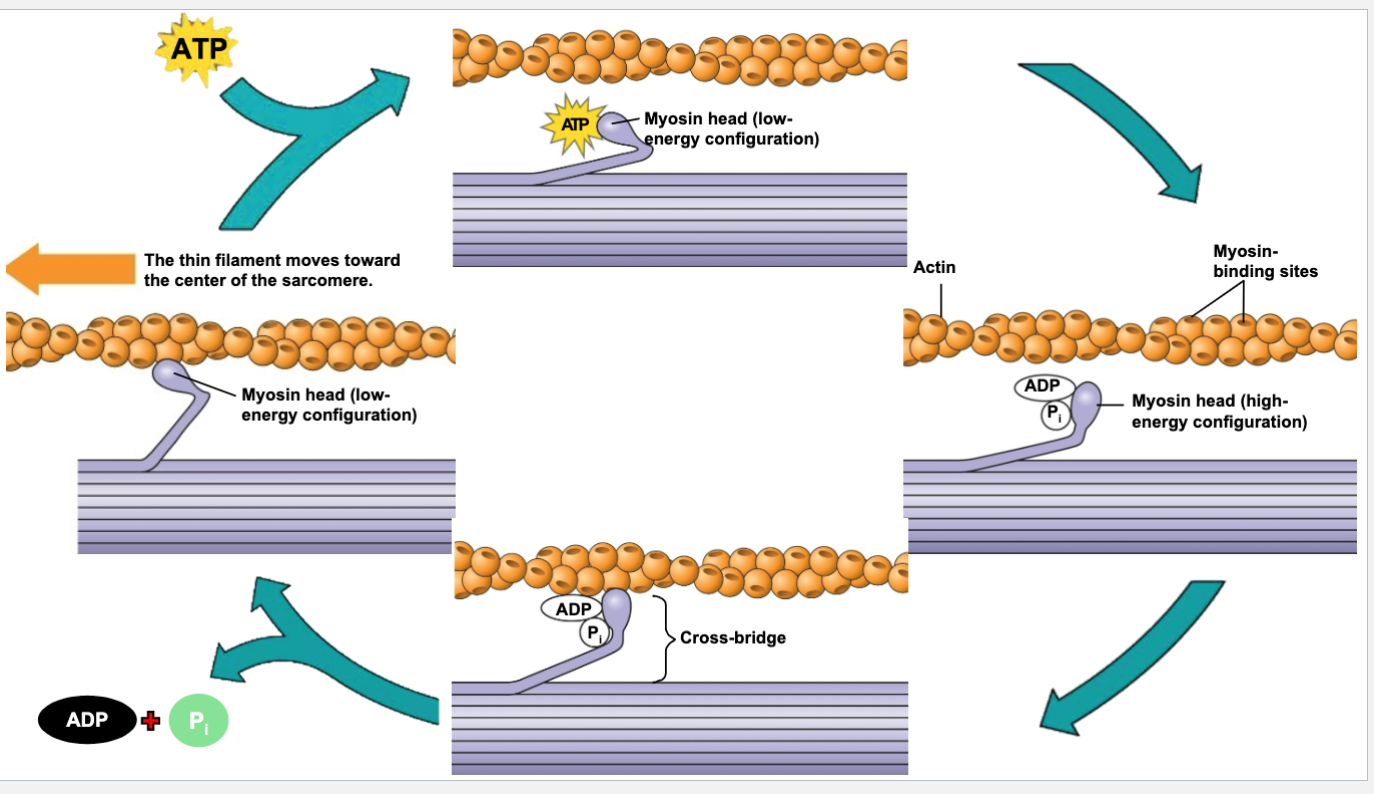Unit 9 Response Mechanisms
1/49
There's no tags or description
Looks like no tags are added yet.
Name | Mastery | Learn | Test | Matching | Spaced |
|---|
No study sessions yet.
50 Terms
different types of muscles found in vertebrates
skeletal, cardiac, and smooth
skeletal muscle
found throughout the body, striated, and responsible for voluntary movements allows muscles to contract and relax
cardiac muscle
found in the heart, striated, intercalated discs (electrical signals), responsible for involuntary contraction and relaxation
smooth muscle
found in hollow organs such as bladder, digestive system and blood vessels. not striated. responsible for involuntary expansion of muscles
hierarchal structure of skeletal muscle from largest to smallest
muscle, muscle fibers, single muscle fiber, myofibril, sarcomere
proteins involved in the contraction of skeletal muscle
tropomyosin and troponin complex
tropomyosin
blocks the myosin-binding sites on actin molecules
troponin complex
controls the position of tropomyosin on the thin filament
interaction of calcium with tropomyosin and troponin during contraction
bind to troponin, causing a change in shape, which moves tropomyosin away from binding sites
interaction of ATP with tropomyosin and troponin during contraction
binds to myosin heads and breaks into ADP and P, this energy released from ATP moves the head into a high energy state. Pulling the actin filament, causing the muscle to contract.
sequence of events associated with the sliding filament theory of muscle contraction
signal arrival, ion release, calcium binding, tropomyosin movement, cross-bridge formation, power stroke, detachment, reseting, and relaxation
signal arrival (sliding filament theory)
a nerve impulse reaches the muscle cell
ion release (sliding filament theory)
the release of calcium ions from the sarcoplasmic reticulum
calcium binding (sliding filament theory)
Calcium ions bind to troponin, causing a change in its shape.
tropomyosin movement (sliding filament theory)
shape change moves tropomyosin away from the binding sites on actin filaments
cross-bridge formation (sliding filament theory)
myosin heads attach to the exposed binding sites on actin, forming cross-bridges
power stroke (sliding filament theory)
energy from ATP, the myosin heads pivot, pulling the actin filaments toward the center of the sarcomere
detachment (sliding filament theory)
ATP molecule binds to the myosin head, causing it to detach from the actin
resetting (sliding filament theory)
myosin head resets to its original position
relaxation (sliding filament theory)
nerve impulse stops, calcium ions are pumped back into the sarcoplasmic reticulum, tropomyosin covers the binding sites on actin again, and the muscle relaxes
sliding filament theory

motor unit
a single motor neuron and all the muscle fibers it controls
how are motor units recruited
depending on the task needed to do, the nervous system controls which motor units are activated and the rate of muscle fiber stimulation
motor units for fine motor skills
precise small movements, less motor units innervated
motor units for gross motor skills
large, powerful movements, more motor units innervated
innervation ratio
number of muscle fibers supplied with neurons by a single motor neuron
antagonistic muscle pairs
muscles that work together in opposite directions (one muscle contracting, and one relaxing)
flexion
decreasing the angle between two body parts
extension
increasing the angle between two body parts
photoreceptors in plants that control their mediate response to light
blue light: phototropins and cryptochromes
red and far-red: phytochromes
blue light receptors
cryptochromes and phototropins
cryptochromes
photomorphogenesis, set circadian clock, seedling flower, stimulate cell expansion in cotyledons and leaves
phototropins
phototropism (growth in response to light)
phototropism
lets plants re-orient shoots in response to light (growing towards light)
photomorphogenesis
allows plants to change shape/grow in response to light
phytochrome signaling
protein that activate a plant, in red and far red light, controlling when plants flower or germinate
plant responses mediated by phytochromes
seed germination, de-elonagtion, shade avoidance, circadian clocks, flowering times
phytochrome signaling affects seed germination
seeds germinate during red light (active form), but not far-red light (inactive form)
photoperiodism
plants physical response to the length of day or night (light periods)
short day plant
(long night plant) flowers when days are shorter than nights and the light period is shorter than critical length,
long day plant
(short night plant) flowers when days are longer than nights and the light period is longer than critical length
phytochrome signaling responsible for shade avoidance
chlorophyll pigments absorb more red-light and allows far-red to pass through
gravitropism
growth response of plants to gravity
gravitropism in roots and shoots
as soon as seed germinates, it ensures that the roots grow into the soil and the shoots grow towards sunlight
thigmotropism
a directional growth of a plant in response to touch or a solid object
thigmomorphogenesis
changes in the morphology (form) of plant resulting from mechanical disturbances. ex. trees growing in windy conditions are shorter and have thicker trunks
nastic movements
non-directional responses to stimuli
photonasty
movement in response to light
thigmonasty
movement in response to touch or mechanical stimulation
thermonasty
movemnet in response to changes in temperature